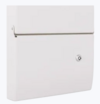Yes, and have done many times. Likewise with Hager.
Interesting . That's reassuring, but I was at least half-expecting you to have a different view from that!
The Hager one says that "each cartridge incorporates its own thermal disconnect mechanism" (and "No secondary back-up protection required" - although it also says "Max backup fuse 125 A" !). If "its own thermal disconnect mechanism" is some internal OPD, I would not have thought that a thermal mechanism would be anything like fast enough to prevent the SPD being destroyed by a transient overvoltage that resulted in an (probably extremely brief) very high current, would it?
The Wylex one says nothing about any 'disconnect mechanism' but merely says "
Fully rated 100A: No need for additional back up device in the consumer unit" - which I presume means that they believe it will not come to any harm if protrected by a 100 A (or smaller) fuse.
This all still leaves me a little confused/uncertain. As you've said, there are very few manufacturers of SPDs, and even that few are very probably producing extremely similar devices, so most of the brands available are probable the same or very similar. That being the case (and ignoring Hager which, as above, may be rather 'different') is there a reason why Wylex feel that SPDs bearing their brand name are adequately protected by the DNOs (100 A max) fuse, whereas all the other brands seem to feel that external (32 or 40 A) external protection is required.
Whilst, as above, your view is certainly reassuring, I have to say that I would be much more comfortable if I understood (and 'agreed with') the reason why Wytlex appear to take a different view than do most/all other companies who sell identical or similar devices.
Also, as I recently mentioned, do we know what is the view of DNOs about one having a device protected only by their cutout fuse - and particularly when that device is actually designed to create L-N or L-E 'short circuits' (albeit usually of very short duration) ?
I have also installed a few others such as Lewden where an MCB was required for the SPD.
Never assume that what one reads in an Internet forum is necessarily correct (see post #2)

Kind Regards, John

 so a MCB powering a SPD would not be seen if it did trip. I know where I worked, electrical panels had to be locked, and I got ticked off by HSE inspector for leaving a key in a panel.
so a MCB powering a SPD would not be seen if it did trip. I know where I worked, electrical panels had to be locked, and I got ticked off by HSE inspector for leaving a key in a panel. so a MCB powering a SPD would not be seen if it did trip. I know where I worked, electrical panels had to be locked, and I got ticked off by HSE inspector for leaving a key in a panel.
so a MCB powering a SPD would not be seen if it did trip. I know where I worked, electrical panels had to be locked, and I got ticked off by HSE inspector for leaving a key in a panel.

